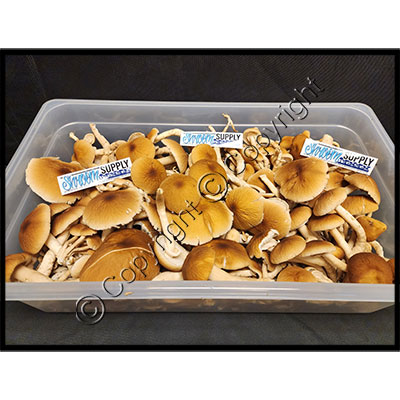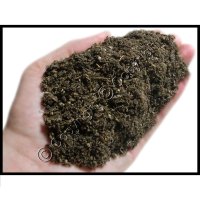
Shroom Supply
mushroom cultivation kits are the easiest all-in-one kits available. Our grow kits are a three stage process:
1) Spawn Production 2) Bulk Substrate Preparation & Colonization 3) Mushroom Fruiting

1) Spawn Production
You should be doing the injection in a
glovebox, or at the very least, a still-air environment. If you are going to work in open air, we suggest turning your AC/heater off an hour prior to inoculating your bags (this reduces the amount of airborne contaminants in the area). It is also recommended to work in a clean, small room with the door closed to prevent airflow.
 Step 1:
Step 1: The first step of inoculating a
grain bag is to prepare it for injection with spores or mycelial culture. Carefully pull the gussets on the bag apart all the way up to the top of the bag, where it is sealed. You want to make sure to "inflate" the bag enough so the filter has some room to "breathe." If the filter is pressed up against the plastic of the bag, it will limit gas exchange during the colonization phase and could potentially stall the colonization process.
 Step 2:
Step 2: Put your gloves on if you have not already. Wipe down the black self-healing injection port with a sterile alcohol swab.
 Step 3:
Step 3: Flame the needle of your syringe for 15 seconds. After flaming the needle, press the plunger of the syringe down slightly and squirt a small amount of solution out of the needle to cool it down. This step is best performed with the assistance of an
alcohol burner because it will not leave any soot on your needle. If a lighter is used instead, wipe off any lighter soot that is left behind on the needle with a sterile alcohol swab immediately after flame sterilization.
 Step 4:
Step 4: Carefully inoculate the bag through the self-healing injection port with 1.5-2 ccs of spore or culture solution.
Repeat steps one through four for the second grain bag that is included in your monotub mushroom grow kit, making sure to use the same mushroom species and strain when inoculating the second bag.
 Step 5:
Step 5: Place your bags in a place that is subject to minimum disturbances and will maintain a temperature between 75 and 81°F. It doesn't matter if it is dark or light. You should see signs of growth 3-10 days after inoculation. Try your best to disturb the bags as little as possible during this time period.
You want the bags in an upright position (not rolled up) with ample space between the filter and the plastic of the bag so it can breathe during this critical colonization time period. See photo above.
 Step 6:
Step 6: After approximately 3-4 weeks, the mycelium will have colonized 70-75% of the bags.
 Step 7:
Step 7: At this point of colonization (70-75%), break the grain up with your hands through the outside of the bag. This will distribute the mycelium and speed up the last phase of colonization. Do not perform this step until mycelial colonization has reached a minimum of 70%, doing so can stall growth.
 Step 8:
Step 8: The mycelium will take several days to recover from getting broken up and should colonize 100% of the bag approximately three to seven days after the prior step (breaking up mycelium) was performed.

2) Bulk Substrate Preparation & Colonization
 Step 9:
Step 9: Prepare your
inflatable monotub by inflating it, plugging the gas exchange holes with the provided
red caps, and lining the bottom with the provided plastic
monotub liner. Wipe down the inside of the monotub, the underside of the lid, and the plastic liner with isopropyl alcohol then put the lid on the tub to keep airborne contaminants out.
 Step 10:
Step 10: Break up both bags of colonized grain with your hands through the outside of the bag. Make sure the grain gets broken up completely and thoroughly.
 Step 11:
Step 11: Cut off a bag containing 5 lbs. of
pre-pasteurized mushroom compost directly below the filter with a clean pair of scissors.
 Step 12:
Step 12: The spawn ratio that we recommend is two pounds of colonized
grain spawn per five pounds of
pre-pasteurized mushroom compost. Cut off two bags of broken-up colonized grain (the bags that you previously broke up) directly below the filter-patch with a clean pair of scissors.
 Step 13:
Step 13: Dump both bags of broken-up grain bag into the 5 lb. bag of compost, mixing a total of two pounds of grain to five pounds of substrate.
 Step 14:
Step 14: Mix the grain/compost mixture by massaging the outside of the bag. It is very important to make sure that the mixture is mixed up thoroughly and that the grain is distributed evenly throughout the bag.
 Step 15:
Step 15: Remove the lid from the
monotub and pour the contents of the mixed bag on to the plastic liner in the bottom of the tub.
 Step 16:
Step 16: After sanitizing your gloves with isopropyl alcohol or
hand sanitizer, use your gloved hands to level out the substrate across the bottom of the monotub into an even layer. Do not tamp or pat the substrate down. Put the lid back on the monotub.
 Step 17:
Step 17: Put the monotub in a dark place that will maintain a temperature between 75-81°F. Disturb the tub as little as possible during this time period and
do not open it until colonization is complete. It will take approximately 5-14 days for the substrate to completely colonize with mycelium (you will be able to tell if it has completed colonization when the substrate has turned completely white). Your substrate should look similar to the photo above.

3) Mushroom Fruiting
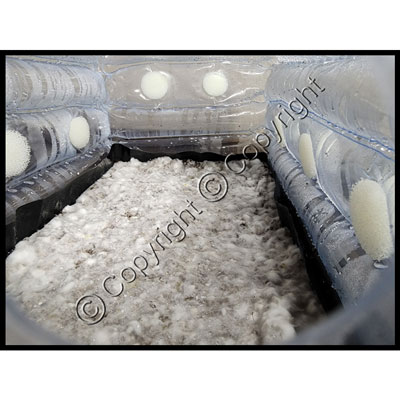 Step 18:
Step 18: It is now time to introduce the monotub to fruiting conditions. At this stage, you will change out the
red caps in your gas exchange hole with the included
1" monotub filters. Introduce the colonized monotub to a scheduled light cycle and keep the tub in an area that will maintain a temperature between 60 and 80°F (this depends on the species you are growing). We recommend using a
full spectrum fluorescent spiral bulb. The more direct your light source is, the better your mushrooms will grow. The light can be left on for 24 hours a day, or you can put it on a 12/12 cycle, either will work fine.
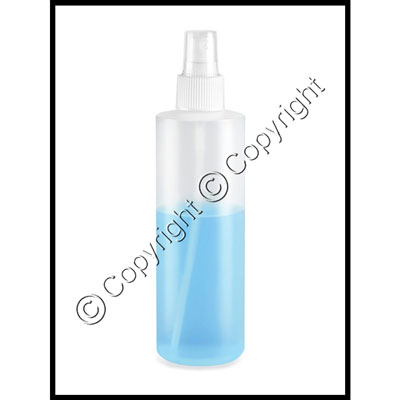 Step 19:
Step 19: Once the monotub has been introduced to fruiting conditions, you need to mist the substrate once per day throughout the entire fruiting stage. Remove the lid from the monotub and lightly mist the substrate with a
misting spray bottle that is capable of creating a fine mist. Approximately ten sprays is sufficient, you don't want to soak the colonized substrate or leave pools of standing water on top of it. If the substrate appears to be fairly moist, you can skip misting on some days.
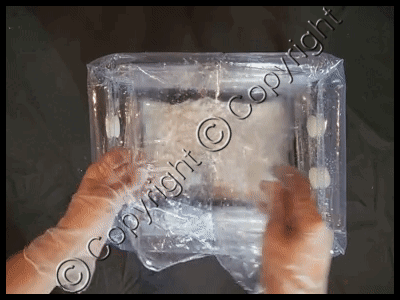 Step 20:
Step 20: Immediately after misting, you need to fan the colonized substrate. The easiest way to fan the substrate is by removing the monotub's lid, folding it in half, then in half again. Repeatedly move the folded lid back and forth, in a steady motion, to create a fan-like effect. This will promote fresh air exchange and vent out any CO2 that has been produced. Fanning should be performed for approximately 30 seconds, twice per day. After fanning, put the lid back on the monotub.
Remember to fan twice per day until the substrate is no longer producing mushrooms.
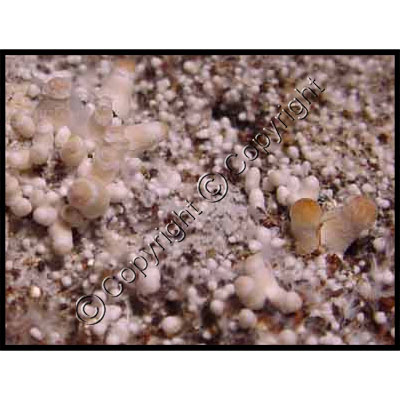 Step 21:
Step 21: After you have introduced your monotub to fruiting conditions and a scheduled light cycle, you will see primordia start to form in approximately 5-10 days. These are miniature pinheads that will eventually turn into mushrooms.
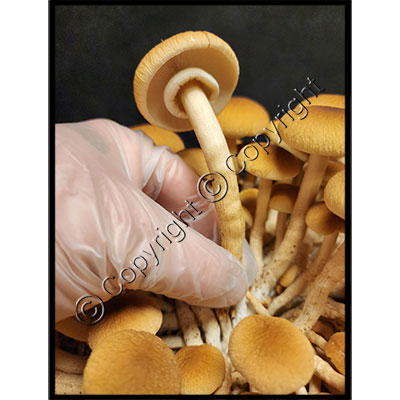 Step 22:
Step 22: The primordia in the previous picture will develop into pins within a couple of days. A couple of days later the veils of the mushrooms will start to open up. Once the majority of the mushroom caps have opened up, it's time to pick them! When you pick the mushrooms, grab them from the base and "root" them up with a clean, gloved hand. If pieces of mushroom fruitbodies are left on the substrate after harvesting, they can rot and become a vector for contamination.
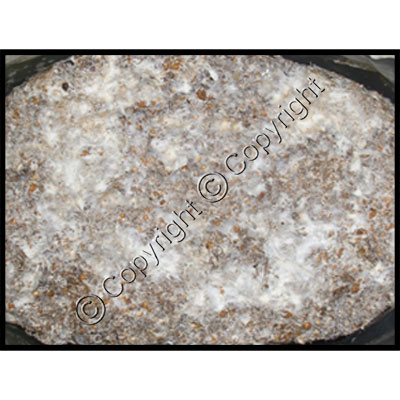 Step 24:
Step 24: Once you pick all your mushrooms, the substrate should be free of all pieces of fruitbodies. It should look like the photo above. This is the perfect time to mist/fan and put the lid back on your monotub. Put the monotub back on its light schedule and wait for the next flush! Remember to continue to mist and fan the monotub daily. You should get 4-5 flushes before the substrate is spent (no longer productive) with about 7-10 days between harvests.
